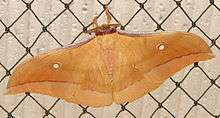Antheraea pernyi
| Antheraea pernyi | |
|---|---|
| | |
| Mounted female | |
 | |
| Living specimen | |
| Scientific classification | |
| Kingdom: | Animalia |
| Phylum: | Arthropoda |
| Class: | Insecta |
| Order: | Lepidoptera |
| Family: | Saturniidae |
| Tribe: | Saturniini |
| Genus: | Antheraea |
| Species: | A. pernyi |
| Binomial name | |
| Antheraea pernyi (Guérin-Méneville, 1855) | |
| Synonyms | |
| |
Antheraea pernyi, the Chinese (oak) tussar moth (or "Chinese tasar moth"), also known as temperate tussar moth, is a large moth in the family Saturniidae. Antheraea roylei is an extremely close relative, and the present species might actually have evolved from ancestral A. roylei by chromosome rearrangement.[1][2]
They are originally from southern China. Used for Tussar silk production, they have been distributed more widely across subtropical and tropical Asia. Unlike the domestic silkmoth which is entirely dependent on human care, tussah silkmoths can survive in the wild if they escape from captivity; small local populations of such feral stock may thus occasionally occur. The colour and quality of the silk depends on the climate and soil.[3]
This is one of the major producers of Tussar silk. It was of commercial importance during the Han Dynasty and early Three Kingdoms era, about 200 BC to 250 AD. More recently, the hybridogenic species Antheraea × proylei is being bred for tussah silk production. It originated from a natural hybrid between male A. pernyi and A. roylei females, F1 females of which were backcrossed to A. pernyi males. For reasons unknown, it is a case of paternal mtDNA transmission: the mitochondrial genome, normally inherited from the mother only in sexually reproducing organisms, is almost identical to that of the present species.[1]
Immune System
The immune responses of A. pernyi to bacterial infection have been analyzed based on injection by Escherichia coli D31. Cecropin B and D, hemolin, attacin and lysozyme were detected in the hemolymph.[4] Also, injection of E. coli led to the discovery of a 380-kDa lectin with affinity to galactose and resulted in an increase of hemagglutinating activity.[5] A. pernyi has been used in research on virus defense in insects. It was discovered that hemolin was induced after injection of baculovirus, but also by double-stranded RNA.[6]
Gallery
-

Eggs one day before hatching
-

First-instar caterpillars
-

Second-instar caterpillar
-

Third-instar caterpillar
-

Fourth-instar caterpillar
-

Fifth-instar caterpillars
-
Sixth-instar caterpillar
-
Sixth-instar caterpillar
References
- 1 2 Arunkumar, K.P.; Metta, Muralidhar; Nagaraju, J. (August 2006). "Molecular phylogeny of silkmoths reveals the origin of domesticated silkmoth, Bombyx mori from Chinese Bombyx mandarina and paternal inheritance of Antheraea proylei mitochondrial DNA". Molecular Phylogenetics and Evolution. 40 (2): 419–427. doi:10.1016/j.ympev.2006.02.023.
- ↑ Peigler, Richard S. "Diverse evidence that Antheraea pernyi (Lepidoptera: Saturniidae) is entirely of sericultural origin". Tropical Lepidoptera Research. 22 (2): 93–99.
- ↑ "CHAPTER 9". Fao.org. Archived from the original on 2012-10-21. Retrieved 2011-10-18.
- ↑ Qu, Xian-ming; Steiner, Håkan; Engström, Åke; Bennich, Hans; Boman, Hans G. (1982-09-01). "Insect Immunity: Isolation and Structure of Cecropins B and D from Pupae of the Chinese Oak Silk Moth, Antheraea pernyi". European Journal of Biochemistry. 127 (1): 219–224. doi:10.1111/j.1432-1033.1982.tb06858.x. ISSN 1432-1033.
- ↑ Qu, Xian-Ming; Zhang, Chun-Fa; Komano, Hiroto; Natori, Shunji (1987-03-01). "Purification of a Lectin from the Hemolymph of Chinese Oak Silk Moth (Antheraea pernyi) Pupae". Journal of Biochemistry. 101 (3): 545–551. doi:10.1093/jb/101.3.545. ISSN 0021-924X. PMID 3298221.
- ↑ Hirai, M.; Terenius, O.; Li, W.; Faye, I. (2004-08-01). "Baculovirus and dsRNA induce Hemolin, but no antibacterial activity, in Antheraea pernyi". Insect Molecular Biology. 13 (4): 399–405. doi:10.1111/j.0962-1075.2004.00497.x. ISSN 1365-2583. PMID 15271212.
- North-Szigetváry, L. (1894): "The Japanese and Chinese Oak-Silk Spinner : Their Life and Cultivation (Attacus Jama-mâi and Bombyx Pernyi)." L. North-Szigetváry, of Newchwang. The Journal of the Manchester Geographical Society. 1894. Vol. 10. Nos. 4–6 April to June, pp. 183–193.
Supplementary figure 1 (JPG) Supplementary figure 2 (JPG) Supplementary figure 3 (JPG)
External links
| Wikimedia Commons has media related to Antheraea pernyi. |
| Wikispecies has information related to: Antheraea pernyi |
- Life Cycle Warning: Many images, may require a lot of bandwidth
- http://www.cdfd.org.in/wildsilkbase/info_moths.php